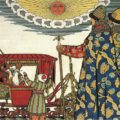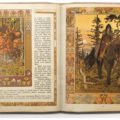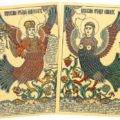Beliefs, legends, fairy tales — these works of oral folk art are passed down from generation to generation and serve as a reliable guide to the world of old customs and traditions. Vivid fairy-tale characters such as Ivan Tsarevich, The Firebird, Vasilisa the Beautiful and Baba Yaga are deeply entrenched in the modern consciousness largely thanks to the talent of the artist and illustrator Ivan Bilibin. The style of his works is unmistakable and incredibly expressive.
Ivan Bilibin was born on August 16, 1876. The renowned painter, graphic artist, and illustrator was one of the greatest masters of the Russian romantic movement in the Art Nouveau style. His colourful illustrations for Russian fairy tales and epics, celebrated for their distinctive ornamentation and design, are known all over the world. Bilibin’s style is unmistakably recognizable: every image is extremely expressive and detailed. However, were it not for his immense passion, the most famous illustrator of Russian fairy tales might not have become an artist.
After graduating from high school with a silver medal, at the insistence of his father, the chief physician of the naval hospital, Ivan entered the law faculty of St. Petersburg University. However, the love of painting prevailed; simultaneously Bilibin began to study drawing at the school of the Society for the Encouragement of Arts, and later he took lessons from eminent artists in the workshop of Ilya Repin. The turning point of his biography was the 1899 exhibition of Viktor Vasnetsov in St. Petersburg, where the famous Knights painting was displayed. The novice artist, who had been following the work of the Wanderers since childhood, was so impressed, that he decided to focus primarily on the illustration of fairy tales. However, initially he did not make illustrations to order, but painted for himself. In order to immerse himself in the atmosphere of folklore and studies of folk decorative art, Bilibin leaves for the Tver province, where he makes sketches of rural life: people, buildings, objects. He would include many of them in his art series called Vasilisa the Beautiful. Later Bilibin spent a lot of time in the ethnographic expeditions, especially to the Russian North. He was getting his inspiration from the Lubok, a Russian popular print, and studied originals, collected antiquities. Thereby his artistic skills were supported by an excellent knowledge of the subject.
While still a student, Ivan Bilibin became a member of the new association of artists called The World of Art, and by the time he graduated from the university he had developed his own, very recognizable artistic style, which later became known as the Ivan Bilibin’s style. Decorativeness of color combinations, patterned, festive drawing and composition — all these motifs would become a canon for Russian and Soviet illustrators for many years. Bilibin drew his impeccable black contours with the thinnest kolinsky brush. His trademark outlines were called steel wire for their clarity and sharpness. The artist filled his outlines with solid colors, which made his works resemble skillful stained glass windows. The process of making the drawings was similar to that of an engraver: a sketch was made on thin paper, then by means of tracing paper transferred onto thicker paper. After that, the artist carefully traced all the lines and only then switched to color. The work was very laborious and painstaking, therefore, he spent several months just in order to create 10 illustrations for one fairy tale.
The artist created his first works in watercolors. He displayed them at the 1900 second World of Art exhibition. The refined Bilibin’s technique was combined with the grace of modernism, popular at that time. The Expedition of Procurement of State Papers, the best Russian printing house, that printed banknotes, and other official products, but rarely published books, became interested in unusual illustrations. The questions of cost and economic feasibility did not matter for the Expedition, since it was generously financed by the state and there were no lack of funds. Its heads were Boris Golitsyn, the prince and famous scientist and academician, and the inventor Georgy Skamoni, who got tired of the monotony of official products and noticed the illustrations of the young artist, offering him a four-year contract. That was how Bilibin’s professional career began and very quickly he became famous as the first book artist in Russia.
Indeed, books with Ivan Bilibin’s illustrations were beautifully done and became the standard of book design of those years. Each book was a well-thought-out single ensemble with a consistent cover, drop caps and patterns throughout. He strove to stylize each of his illustrations to resemble an old manuscript, and the pages were lavishly decorated with rich ornamentation reminiscent of carved window frames.
It is not surprising that folk tales illustrated by the artist quickly became fashionable and famous all over the world. His works include the popular The Frog Princess, Vasilisa the Beautiful, Mary Morevna, Feather of Finist Clear Falcon fairy tales, Pushkin’s The Tale of Tsar Saltan and The Tale of the Fisherman and the Fish. Ivan Bilibin’s illustrations for Russian fairy tales and epics recreate the fabulous and fantastic world of Russian folklore.
Along with book illustrations, Bilibin worked a lot for the theater: he made sketches of scenery for Sadko and The Golden Cockerel operas by Rimsky-Korsakov, for Boris Godunov by Modest Mussorgsky in the Diaghilev theatre, for the Ruslan and Lyudmila opera by Mikhail Glinka.
In addition, Ivan Bilibin taught at the All-Russian Academy of Arts, together with other artists created the Society for the Revival of Artistic Russia, wrote articles with the studies of folk art for the World of Art magazine. Without exaggeration, he became a real star in Russia of the beginning of the 20th century, a famous decorator of the most high-profile theatrical performances and an illustrator of expressive book novelties. The artist designed the coat of arms of the Provisional Government, which was based on images of Ivan III era. It depicts a two-headed eagle with lowered wings without imperial regalia. Since 1997, this very eagle has become the logo of the Bank of Russia and is engraved on modern coins and printed on banknotes.
The artist became famous before the revolution and lived in exile for many years. He returned to his homeland in his declining years. Ivan Bilibin died during the blockade of Leningrad in February 1942 at the age of 65.
This article was prepared in cooperation with the staff of Your Restorer restoration workshop.
Maria Maksakova (text),
Denis Onosov (photo)



